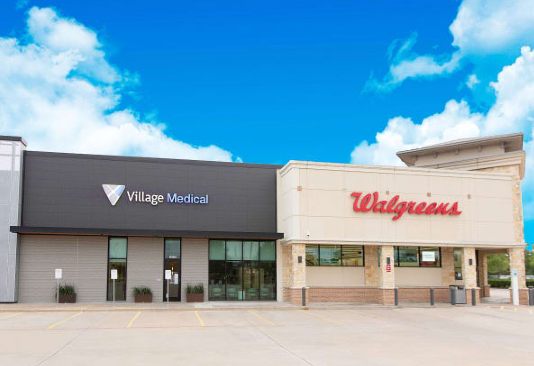Walgreens Boots Alliance will soon have doctor offices inside of hundreds of its U.S. drugstores.
The pharmacy chain said Wednesday it has struck a deal with VillageMD, which will staff and run the primary-care clinics. The companies said they will open the clinics in 500 to 700 stores in more than 30 U.S. markets over the next five years.
Walgreens shares, which are valued at $37 billion, rose about 3% in premarket trading on the news. Since January, the stock has fallen more than 28%.
Walgreens will invest $1 billion in equity and convertible debt in VillageMD over the next three years as part of the deal, including a $250 million equity investment completed Wednesday. Most of the money will be used by VillageMD to open the clinics and integrate its technology with Walgreens.
VillageMD will recruit and pay employees’ salaries, cover other operating expenses and pay Walgreens to use the space. Walgreens said it will own about 30% of the primary-care company after the multiyear investment.
Walgreens is expanding its focus on medical care as it cuts costs and invests in new areas. It has closed hundreds of stores and laid off employees, while experimenting with innovative business models. The company wants to turn its drugstores into health and wellness destinations where people spend more time and money. For example, it leases space in some stores to optical company For Eyes and weight loss company Jenny Craig. The chain is also testing a small-format pharmacy designed to strengthen relationships between pharmacists and patients, particularly those on multiple medications.
Walgreens already has 14 primary-care centers in its drugstores, through partnerships with providers VillageMD, Partners in Primary Care and Southwest Medical Associates.
Investors and analysts will get an update on how the company’s efforts are going during the coronavirus pandemic on an earnings call Thursday morning.
Wide range of services
Through the new partnership, patients will be able to visit the Village Medical at Walgreens clinics for a wide range of medical services from annual checkups to walk-in appointments if they feel sick. Each clinic will have nine exam rooms, a waiting area and a four-person physician-led staff that coordinates with store pharmacists. They can also request a home visit or get care around the clock through telemedicine.
Walgreens and VillageMD will convert an existing part of drugstores into the clinics. Most clinics will be about 3,300 square feet — nearly a quarter of the drugstore’s average size of 13,500 square feet. Some will be as large as 9,000 square feet.
The companies did not share specific costs for services but said Village Medical clinics will accept different kinds of health insurance, often with copays of up to $10, and allow people to pay out of pocket. For those without insurance, it uses a sliding scale to make care affordable, it said.
Rivals expanding into health care
Walgreens and VillageMD will face stiff competition. Walmart has opened four primary-care clinics, with plans for more. The big-box giant’s clinics, called Walmart Health, emphasize its signature low costs and upfront pricing. Amazon’s acquisition of online pharmacy PillPack underscores its broader health-care ambitions. And CVS Health, which acquired health insurer Aetna, plans to by the end of 2021. The redesigned stores have a variety of health-related features such as expanded clinics, wellness rooms for yoga and more medical-related products.
Walgreens co-Chief Operating Officer Alex Gourlay said there’s still plenty of demand to go around. He pointed to the high number of Americans who live with at least one chronic condition that requires multiple daily medications — 6 in 10 Americans.
Over the past several months, Walgreens and VillageMD have tested the new primary-care model. They opened five in-store clinics in the Houston area in November and said they decided to scale up after getting positive reviews from patients.
Gourlay said the clinics will help Walgreens increase the number of prescriptions it dispenses and health-care products it sells — something he said it’s already seen in pilot locations. He said it will go beyond that, too, shaping the way the public thinks of it.
“It’ll start to change the feel of Walgreens, particularly these locations, to be a health-care company,” he said.
Serving unmet needs
VillageMD CEO Tim Barry said the new model can rein in costs and improve health outcomes, particularly for those with chronic diseases, such as diabetes. Since many of Walgreens’ locations are near people’s homes, he said people will be more likely to go for regular doctor appointments or get a medical matter checked sooner. That earlier intervention and ongoing relationship with a doctor could help keep people out of the emergency room or hospital — or at least lower costs that can escalate as a health problem becomes a crisis, he said.
He said the format encourages frequent communication between pharmacists and doctors, since they work nearby. For example, the pharmacist could suggest a lower-priced drug, flag potential interactions between medications or help sync up multiple prescriptions so the patient can pick up refills all on the same day.
Barry said the company aims to flip the typical approach. Instead of “giving someone a referral slip or handing them a prescription,” it wants to be proactive. He said clinics can see about 100 to 120 patients per day.
More than 50% of the new primary-care clinics will open in areas with a shortage of health professionals and a population that’s underserved. The U.S. Department of Health and Human Services designates those areas based on certain criteria, such as the number of people nearby who have low-incomes, qualify for Medicaid or experience homelessness.
Barry said those locations will help VillageMD reach “older, sicker and poorer populations” that often do not have access to care.
Gourlay said it furthers Walgreens’ mission, too.
“We want to be everywhere in America where people need health care,” he said. “That’s always been our position and always will be.”

